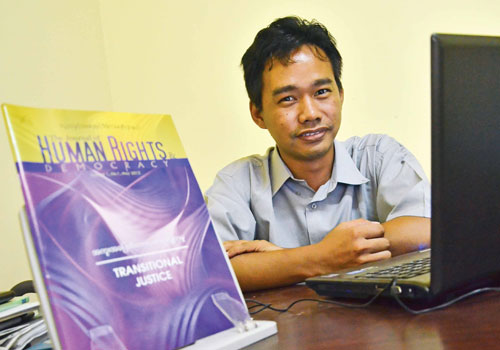
YANGON (The Myanmar Times / Pacific Media Watch): Until recently, the Journal of Human Rights and Democracy would have been an unlikely addition to Myanmar’s publishing scene.
However, its founders are set on tackling the country’s toughest issues, starting first with transitional justice, The Myanmar Times reports.
Editor-in-charge Nyunt Win explained the concept behind the journal and the editorial team’s plans for future issues after a former Pacific Media Centre journalist and researcher, Violet Cho, had an article published in the inaugural edition.
How did the Journal of Human Rights and Democracy come about?
Some of my old friends and I have been working on this project for more than a year. We think now is the best time to promote key concepts about liberal democracy and human rights because we have more space to write. Myanmar has a huge vacuum in this kind of literature. We also publish books … on a variety of topics related to human rights, democracy and culture [that] focus on the theories, concepts and case studies [but] the journal focuses on the current political transition and the way it is moving. The first issue was mainly about transitional justice, the second [which will be released later this month] will be about ethnic conflict and peace building in Myanmar, the third issue will be a review of the 2008 constitution and the fourth will focus on freedom of speech.
How do you assess the human rights conditions in Myanmar at present and what is the level of awareness about human rights issues among ordinary people?
As the result of about 50 years of direct or indirect military rule, human rights problems in Myanmar have reached a [critical] stage. Previous regimes not only systematically violated the human rights of the people but they also systematically blocked all channels for people to [protect] their rights. Booklets about the Universal Declaration of Human Rights were banned and being caught with one could mean at least seven years in jail. Over the past 50 years, human rights violations and a culture of impunity for the perpetrators became firmly rooted in all social strata. People did not know that their rights were being violated and those who did could not do anything to seek justice. Only now can we start to educate all stakeholders about human rights concepts.
But has the situation improved under the current government?
Human rights violations have not completely stopped since the “civilian” government took power in 2011. A significant proportion of the population is still facing widespread violations, including intimidation from the authorities, the loss of land and property rights, alleged rapes and sexual harassment, persecution, discrimination and marginalisation of minority ethnic and religious groups, blockage of access to justice, influence of the executive and their cronies on the judiciary; and exploitation of labour and poor work conditions. The promulgation of laws on freedom of assembly and expression mean we have seen improvements in exercising our basic human rights but there are still strings attached, such as Article 18 of the peaceful protest law. Rights activists are still often detained, jailed or intimidated, albeit to a lesser degree compared to the [military] era. The human rights crisis is worst in areas affected by the armed conflict. Local populations fear both parties and fall prey to human rights violations by both sides.
What feedback did you get following the launch in May?
The feedback has been generally good. Many of the audience are impressed by the quality of our essays, the layout design and the print quality. There are a few who say the content is a little “dense” to read. This may be because our target audience is those who are actively involved in or trying to get involved in the political process or, at least, interested in it. I didn’t see any advertisements in the journal – how do you cover the costs of publishing? We get funding from Norwegian People’s Aid, one of Norway’s two official aid agencies. We plan to expand our organisation to also include a training centre in the future and we are seeking support from international donors or aid agencies for this training. In the future though we will phase out the [donor] funding and try to transform [our publishing house] MKS into a social enterprise.
As the editor-in-charge, what role do you play in putting the publication together?
Most articles are contributed by members of the editorial team. We also print contributions by freelance writers and scholars, both local and international. Most outside contributors are from within our social network. We set the cover theme for the issue and discuss the content and make assignments among the staff editors … [and] outside contributors … Also, when we come across a good [piece of] analysis or research that is relevant to the topic of an issue, we contact the original author and ask for permission to print their work.
How many copies did you print for the first issue?
The print run for the first issue was slightly more than 1000 copies but we’ll double it for the second issue. The cover price is K1500 [$2] but as an advocacy organisation we also give complimentary copies to MPs, party members, related NGOs and our friends. We also distribute free copies at events, such as talks at the Union of Myanmar Federation of Chambers of Commerce and Industry. Have freedom of expression and the media industry generally in Myanmar improved? The media industry in Myanmar still needs to learn more about professionalism, I think. This does not mean the local media has to follow … the Western media or copy its style and processes. We must learn from them about critical thinking and presentation [of topics] but we have to set our own editorial agenda.
This work is licensed under a Creative Commons Attribution-NonCommercial 3.0 New Zealand Licence.




